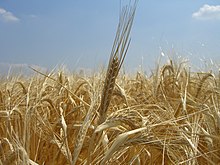Malting barley
In contrast to feed barley , brewing barley is a barley that is grown for brewing purposes and thus for human consumption.
use
Malting barley is in the malting to malt processed and is used as a ge schrotetes malt in breweries , as ground baking malt in the baking industry, as whiskey - and Brennmalz in the spirits industry , as coffee substitute for or. B. in breakfast cereals . Almost all types of grain can be used for brewing and malting. However, barley has established itself as the main raw material alongside wheat. The husks of the barley are of technological importance in the brewery, because they form a natural filter layer when the mash is lautered to separate the wort from the spent grain . In addition, of all grain types, barley has the highest activity in starch-degrading enzymes, which is important for the rapid saccharification of the starch in the brewhouse of the brewery.
sorts
Malting barley is mainly made from two- row spring barley . Through plant breeding , new two-row winter brewer barley varieties have emerged in recent years, which are already very close to the quality of summer brewer barley varieties. In addition, mostly in France, six-row winter malting barley is also grown.
Quality criteria
Only special brewing barley cultivars are suitable for use as brewing barley. In Germany, the Berlin program was launched to identify the best brewing barley varieties for each vintage. Brewing barley is mainly grown in breweries and malting plants for its high extract value and good processability. In addition to the brewing barley variety, the barley must meet specified quality criteria after harvest in order not to be marketed as feed barley.
A brewing barley should:
- a low protein content between 9.5% and 11.5%
- a high germination energy of at least 95 to 97%
- good solution properties
- a high extract content
- the highest possible degree of final fermentation
- Whole barley content (sieve size> 2.5 mm) of at least 85%
- a plaster (screen size <2.2 mm) of a maximum of 2.0%
- a water content of at least 12 and at most 15%
exhibit.
storage
Since the brewing barley has to germinate during processing in the malt house in order to set the biochemical processes in the grain in motion , the ability to germinate , but even more so the germination energy , is an important criterion. Only living grains are capable of germination, which is why brewing barley, unlike feed barley and other types of grain, must be adequately ventilated during storage. Immediately after the harvest, the barley shows dormancy , which is usually only overcome after a few weeks. Therefore, in Central Europe, the harvest is usually not processed until September. The germination capacity / energy can decrease during storage, so that malting barley is usually only stored and processed until the next harvest. In particularly dry harvest years , however, these parameters can also be maintained well beyond this point in time.
economics
The cultivation of brewing barley has declined sharply in Germany and most European countries in recent years. While farmers used to grow spring barley, select part of the harvest as brewing barley and market most of it as fodder barley, due to the competition for land with other types of grain and especially with renewable raw materials, spring barley is now grown almost exclusively for brewing purposes. This increases the pressure on the farmer to be able to market the barley as brewing barley, since a downgrade to fodder barley results in significant shortfalls in income. This marketing risk calls for a premium, the so-called brewing barley premium, which breweries and malt houses are only prepared to pay to a limited extent in a highly competitive environment.
literature
- Reinhold Schildbach : Grain and brewing grain - worldwide: types, varieties, cultivation, breeding and processing in agriculture, food, brewing and beverage industries. VLB publication, Berlin 2013, ISBN 978-3-921690-75-8 .
- Alfred Steven: The German brewing barley industry. Basics and suggestions for the promotion and refinement of domestic barley growing. Association for the Promotion of German Brewing Barley, Berlin 1927
Web links
Individual evidence
- ^ A b Brewing barley community: Description of German brewing barley
- ↑ Berlin program
- ↑ proplanta: acreage for brewing barley continues to decrease dramatically
- ↑ Chamber of Agriculture Rhineland-Palatinate: A chance for brewing barley ( Memento of the original from February 1, 2016 in the Internet Archive ) Info: The archive link was inserted automatically and has not yet been checked. Please check the original and archive link according to the instructions and then remove this notice.

